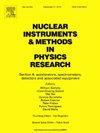Suppression of bunch destruction under resonant excitation of the plasma wakefield
IF 1.4
3区 物理与天体物理
Q3 INSTRUMENTS & INSTRUMENTATION
Nuclear Instruments & Methods in Physics Research Section A-accelerators Spectrometers Detectors and Associated Equipment
Pub Date : 2025-07-22
DOI:10.1016/j.nima.2025.170851
引用次数: 0
Abstract
Plasma wakefield acceleration offers a compact and efficient method for generating high-brightness relativistic electron beams. Applications such as free-electron lasers and particle colliders demand high-quality bunches with stable, predictable profiles. However, previous studies have shown that a resonant sequence of electron bunches, where the spacing matches the plasma wavelength is prone to longitudinal instability, leading to progressive bunch destruction by gradual defocusing. In this work, we analyse the underlying mechanism of this instability, which arises from a phase shift between the bunch and the wake radial focusing force during the system’s evolution. We propose and validate, both numerically and analytically, a method to suppress the instability by shifting all bunches relative to the first into regions of the wakefield where is focusing and longitudinal derivative is maximized, ensuring stable propagation.
等离子体尾流场共振激发下束破坏的抑制
等离子体尾流场加速为产生高亮度相对论性电子束提供了一种紧凑而有效的方法。自由电子激光器和粒子对撞机等应用需要具有稳定、可预测轮廓的高质量束。然而,先前的研究表明,当电子束的间距与等离子体波长相匹配时,其共振序列容易出现纵向不稳定,导致电子束逐渐离焦而逐渐破坏。在这项工作中,我们分析了这种不稳定性的潜在机制,这种不稳定性是由系统演化过程中束和尾流径向聚焦力Fr之间的相移引起的。我们提出并验证了一种方法,通过将相对于第一个束的所有束移动到尾流场中Fr聚焦且纵向导数∂zFr≠0最大化的区域来抑制不稳定性,从而确保稳定的传播。
本文章由计算机程序翻译,如有差异,请以英文原文为准。
求助全文
约1分钟内获得全文
求助全文
来源期刊
CiteScore
3.20
自引率
21.40%
发文量
787
审稿时长
1 months
期刊介绍:
Section A of Nuclear Instruments and Methods in Physics Research publishes papers on design, manufacturing and performance of scientific instruments with an emphasis on large scale facilities. This includes the development of particle accelerators, ion sources, beam transport systems and target arrangements as well as the use of secondary phenomena such as synchrotron radiation and free electron lasers. It also includes all types of instrumentation for the detection and spectrometry of radiations from high energy processes and nuclear decays, as well as instrumentation for experiments at nuclear reactors. Specialized electronics for nuclear and other types of spectrometry as well as computerization of measurements and control systems in this area also find their place in the A section.
Theoretical as well as experimental papers are accepted.

 求助内容:
求助内容: 应助结果提醒方式:
应助结果提醒方式:


